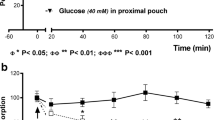Conclusions
1. The administration of mecholyl by iontophoresis produces an alkaline mucous gastric juice as effectively as it does when given by subcutaneous injection. Furthermore, the method of iontophoresis with mecholyl for the production of an alkaline juice has distinct advantages over its administration by subcutaneous route, namely, the effects of the drug are not so explosive; the drop in blood pressure is not so sudden or marked; and the period of time of the alkalinity is markedly increased. For these reasons the former method would appear to be the method of choice for its possible therapeutic application in gastric ulcer. The administration of prostigmin before iontophoresis of mecholyl is strongly recommended, since the effects of mecholyl are regularly enhanced. By the use of these two drugs the alkalinity of the gastric juice can be maintained for two hours or longer.
2. Iontophoresis of benzedrine causes a slight increase in the acidity of the gastric juice associated with a rise in blood pressure. These changes are not so marked as when the drug is administered by parenteral route.
3. The administration of histamin by iontophoresis results in a much greater increase in gastric acidity than does benzedrine.
4. The administration of prostigmin by iontophoresis causes no significant changes in the acid level of the gastric juice.
Similar content being viewed by others
References
Frankhenhäuser, F.: Die Leitung der Elektrizität im lebenden Körper. Berlin, Hirschwald, 1898.
Untersuchungen ueber die perkutane Einverleibung von Arzneistoffen durch Elektrolyse und Kataphorese.Ztschr. f. exper. Pathol. u. Therap. Bd. II, S. 256, 1905 u. Bd. III, S. 331, 1906.
Ueber Iontophorese.Ztschr. f. physikal. u. diäb. Therapie. Bd. XL, 1907.
Leduc, H.: L’introduction des substances médicamenteuses dans la profanduer des tissus par le current électrique. Internat. Kongress f. Medizin, Elektrologie u. Radiologie, Paris, 1900. Ref.:Ztschr. f. Elektrotherapie, 1900.
Les jous et les médicamentations jouiques. Paris, 1907, Masson et Cie.
Wirtz, R.: Die Ionentherapie in der Augenheilkunde.Kl. M. f. Augenh. Bd. II, S. 547, 1908.
Schnyder, W. F.:Klin. Mon. f. Augenh., 1909, 433–502: Die Iontophorese in der Ophthalmologie.
Bos: Dissert. aus der Klinik v. Prof. Rochat, Groningen, 1929. Cited by G. Erlanger inJahresk. f. Arztl. Fortbild., 23, 22–37, Nov., 1932.
Erlanger, G.: Zur Winkung der Iontophorese bei Augenleiden.Dtsch. Med. W., 46, 2:1107, 1920.
Elektrische Einverleibung von Pharmaka (Iontophorese) ins Auge.Jahresk. f. Arztl. Fortbild., 23:22–37, Nov., 1932.
Kovacs, J.: Iontophoresis of Acetyl-Beta-Methylcholine chloride in treatment of chronic arthritis and peripheral vascular disease.Am. J. Med. Sci., 188:32, July, 1934.
The peripheral blood circulation in chronic arthritis and the influence of vasodilators.J. A. M. A., 103:1803, Dec. 8, 1934.
Abel, O.: The use of mecholyl in arthritis.J. Missouri St. Med. Assn., 351–353, Sept., 1935.
Saylor, L., Kovacs, J. and Duryee, A. W.: The treatment of chronic varicose ulcers by means of acetyl-Beta-methylcholine chloride iontophoresis.J. A. M. A., 107:114–117, July 11, 1936.
Kotkis, A. J. and Melchionna, R. H.: Physiologic effects of acetyl-Beta-methylcholine chloride (mecholyl) by iontophoresis; preliminary report.Arch. Phys. Therapy, 16:528–533, Sept., 1935.
Alexander, W. F. and Kotkis, A. J.: The properties of the physiologically active substance in the body resulting from the administration of acetyl-Beta-methylcholine chloride by iontophoresis.J. Pharm. and Exper. Therapy., 58, 4:439–453, Dec., 1936.
Myerson, A., Loman, J. and Rinkel, M.: General and local sweating produced by acetyl-Beta-methylcholine chloride (mecholyl).Am. J. Med. Sci. (in press).
Myerson, A., Rinkel, M. and Dameshek, W.: The autonomic pharmacology of the gastric juices.New England J. Med., 215, 22:1005–1013, Nov. 26, 1936.
Myerson, A., Loman, J. and Dameshek, W.: Physiologic effects of acetyl-Beta-methylcholine (mecholyl) and its relationship to other drugs affecting the autonomic nervous system.Am. J. Med. Sci. (in press).
Myerson, A., Loman, J. and Damashek, W.: Physiologic effects of benzedrine and its relationship to other drugs affecting the autonomic nervous system.Am. J. Med. Sci., 192, 4:560–574, Oct., 1936.
Author information
Authors and Affiliations
Additional information
From the Division of Psychiatric Research, Boston Stae Hospital, Mattapan, Mass., aided by grants from the Commonwealth of Massachusetts, the Herbert L. Celler Foundation and the Rockefeller Foundation.
Rights and permissions
About this article
Cite this article
Loman, J., Rinkel, M. & Myerson, A. Human autonomic pharmacology. American Journal of Digestive Diseases and Nutrition 4, 386–390 (1937). https://doi.org/10.1007/BF02999939
Issue Date:
DOI: https://doi.org/10.1007/BF02999939




